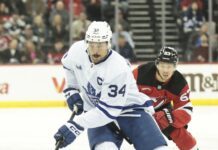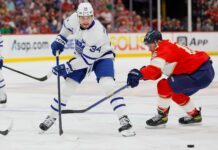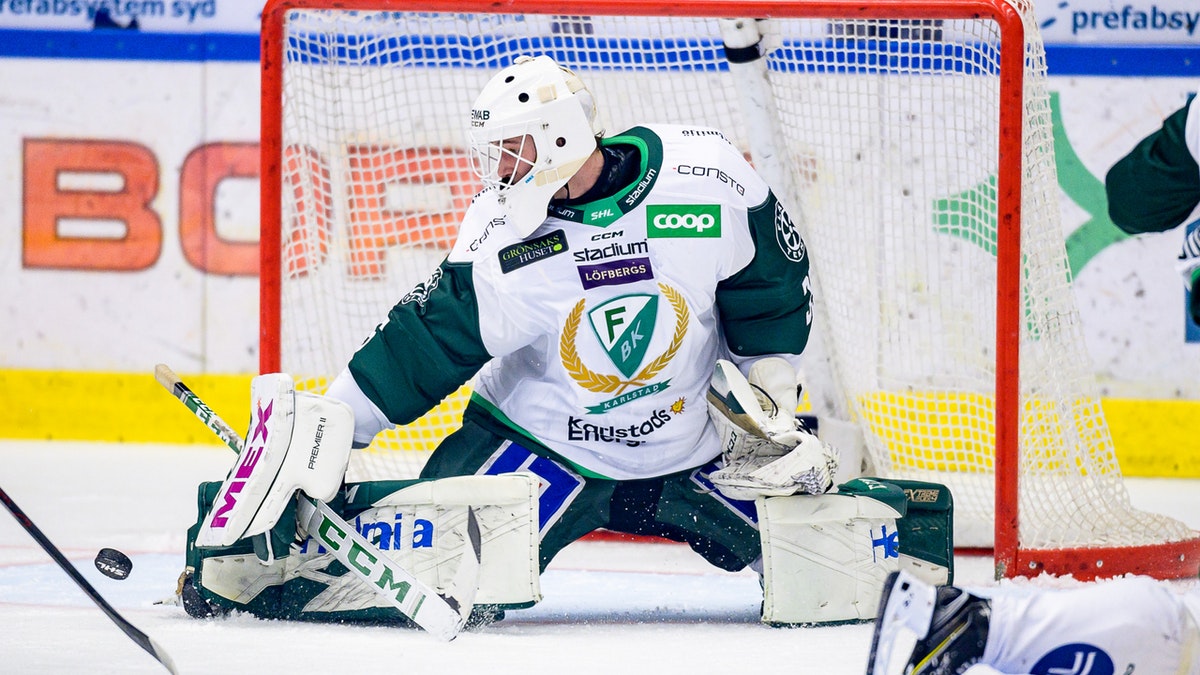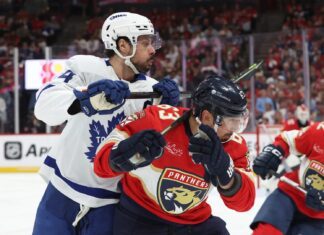With their 122nd overall selection in the 2022 NHL Draft, the Maple Leafs selected a 6’6″ overage Swedish goaltender in Dennis Hildeby of Färjestad BK.
This marks the sixth time in the past seven drafts that the Leafs have selected a goalie. Obviously, none of them have panned out into a viable starter, which is partly the point here. Goaltending is the most volatile position to project at any level; whether that’s evaluating current goalies in the NHL or 17-year-old kids, it is still largely a guessing game.
The pick also comes in a bit of a run on goalies during this draft itself. There were five goalies selected in the fourth round, and the Leafs traded into this pick to make sure they got one of them. It’s akin to taking swings until something eventually connects, but that’s partly the game when it comes to goalies.
The reality is the Leafs haven’t drafted a goalie of note since James Reimer — and, of course, Tuukka Rask the year before that selection. They have to keep taking kicks at the can and working on developing these goalies until one of them pans out. At some point, if none of them do, some larger questions about their goalie development plans and overall goalie scouting will need to be asked.
You can make the case for already asking them. It hasn’t been the same staff in place since 2006, but going 16 years without developing a goalie of consequence is an indictment on the franchise. Brendan Shanahan was hired in April of 2014. This is the sixth goalie the Leafs have drafted under his watch.
As far as Hildeby specifically is concerned, he has good size for a goalie (6’6), played some pro hockey in the Swedish Hockey League against men, and put up good numbers in the process: a .930 save percentage and one shutout in seven games on a good team.
It is noteworthy that Hildeby is a triple overager. He is a 2001-born. At that age, he probably needed to flash potential playing pro hockey or he wouldn’t have had the resume otherwise to justify a fourth-round selection.
Hildeby has a contract in Sweden through the 2023-24 season, but we will see if there is a plan to come over sooner. He’d need to join the Marlies to adjust to the North American game. That means, even though he is a little older and potentially closer, there is still a decent amount of projection taking place with this pick.
Surprisingly, the Leafs have not drafted someone from Sweden since Pontus Holmberg in the sixth round of the 2018 draft. They have had some success drafting from Sweden in years before that, including Timothy Liljegren and Carl Grundstrom — to say nothing of William Nylander, Pierre Engvall, and Andreas Johnsson before then. If nothing else, picks out of Sweden have been a good omen for this organization over recent years.
Update: On July 13, 2022, Hildeby has become the first to sign an entry-level contract among the players selected in the 2022 NHL Draft.
🖊 We’ve signed goaltender Dennis Hildeby to a three-year, entry-level contract. #LeafsForever
— Toronto Maple Leafs (@MapleLeafs) July 13, 2022
Dennis Hildeby Scouting Report
courtesy of the 2022 Blackbook (BUY NOW)
Dennis Hildeby is one of the oldest draft-eligible goalies, while also being the biggest. During the 2019 season, he transitioned from Timra’s system into Farjestad’s system, where he remained this past season. In his initial year of eligibility, he had the reflexes and the height but lacked some situational tracking and the consistency we look for. This past year, he showed real improvements in critical areas.
At the J20 level, he was responsible for a couple of memorable games, including multiple 50+ save performances. His teams were overrun yet he stood tall and showed a tremendous amount of poise between the pipes. His mental maturity had caught up to his already-impressive level of coordination and reflexes, which made him a late-season addition at the SHL level, where he didn’t disappoint.
With a bigger goalie, you’re evaluating their reflexes compared to their frames, since they need to be able to transition in and out of different save types as seamlessly as possible. Their larger frames counteract their transitional speed relative to smaller goalies in most cases. Typically, the bigger the goalie, the longer a transitional phase between movements lasts when adjusting to broken play types after miscues or misreads.
Mads Soogard was a good example of a very big goalie who had tremendous functionality within these qualities coming out of a recent draft. Hildeby shares these same traits. To go with those traits, he also features specific qualities needed to make angular adjustments, such as micro shuffles and transitional fluidity between his RVH and lateral-extension saves.
One of his improved areas for us was his understanding of how to time these lateral shuffles, combined with timing when he needed to go from a relaxed position into a set stance. This is a critical component of how a larger goalie needs to operate. When entering their set position, they rely primarily on dropping into their butterfly before extending with their lower and upper half, but if the set position occurs too late within the shooting window, it takes away the butterfly entirely.
When transitioning between his butterfly and into his leg extensions, Hildeby grades extremely well. He remains compact before extending and he has a unique ability to absorb high shots at odd angles by moving off his midline and rotating his shoulders upward towards the top of the net. Blocker cupping is common, especially when shots are labeled between the arms, yet Hildeby has learned to cup on both his blocker side and glove side.
From a visual perspective, this means that instead of trying to extend his arm outward to catch the puck, he extends his arm inward and flares out his elbow so that it’s parallel to the ice. This save type usually only occurs after the trajectory of the shot has been altered or the goalie has misread the initial placement. Part of this is an adaptation to the way he catches the puck. In his set stance, he uses a neutral glove position in tight to his body, which makes it more natural for him to flow between these types of extensions and cupping techniques.
There are different qualities presented within his RVH which helped round out his game. On the one hand, his post integration within the position is good. He stays tall and balanced within his RVH. When factoring in his height, it gives him a significant advantage when inadvertently collapsing too quickly into this save type after assessing a potential shot from a wider angle or when a player cuts aggressively from below the goal line out to the front of the net.
In addition, he’s consistent with his skate positioning relative to the post, so that he can laterally transfer seamlessly across the net to get out in front of high-danger lateral one-timers. When the puck is around his net area or down in the corners, we like his timing when coming in and out of the movement as a whole.
Goalies such as Jacob Markstrom can spend too long in the RVH position when assessing the length of the puck relative to his net, and as a result, they can get burned when needing to transition back into a standing position. As an example, when a forward circles behind the net and then cuts around the boards before firing a pass back to the point, if he has mistimed when he needs to re-enter his standing position, he can fail to get properly set for the potential one-timer option from high — and even low — danger areas such as the point. Hildeby is advanced when it comes to recognizing the precise timing to switch between his RVH and standing position when the puck is in a non-threatening area.
However, during rush sequences, he sometimes mistimes his RHV and gets caught in between his movements — although this was more common at the SHL level compared to J20, as he was still occasionally adapting to the speed of the game.
Mechanically, his butterfly has also improved since his initial draft season when it comes to abruptly angling pucks into corners after shots are deflected off of the outside of his frame. His butterfly is tall and he mostly remains balanced, allowing him recovery opportunities when needing to adjust.
If he can’t absorb the puck, he typically carries good stick positioning, which allows him to sweep pucks out of harm’s way directly after collapsing into his butterfly. Most importantly, he seals himself inward when absorbing pucks, making it rare for shots to leak through him within this position.
His micro-adjustment skillset is impressive for his size. One viewing against Skelleftea at the SHL level really emphasized just how many different save types he can position within a small window of time. These adjustments and transitional movements can’t occur without him having a good skating base — that’s another improved area. He can use his edgework to contain himself at a higher rate, and as a result, it was rare for him to throw himself out of position. Pucks usually had to beat him as opposed to him beating himself by inadvertently breaking his technique or losing the net too often.
Smart goalies typically don’t get set at improper angles too often. Hildeby has really improved the last three years at tracking, which has helped him remain more consistent at recognizing the initial angle of the shot, allowing him to get set and square ahead of the shot attempt. One of the most difficult assessments within goaltending is trying to predict future situational reading and tracking; unlike forwards and defense, who only have small windows of improvement within their ability to read the game in most cases, goalies can differ.
James Reimer immediately comes to mind as a goalie who struggled mightily with his reads behind the net when he first entered the NHL, and now it’s not much of a weakness. Elvis Merzlikins had a similar issue with tracking shots through screens that featured rapid lateral-angle shifts from the hashmark areas; now, he’s adjusted under Manny Legacy at a rate that we didn’t actually predict — and he’s doing it on a smaller ice surface.
Some of Dennis’ best saves were the result of him recognizing sudden angle shifts behind screens, or timing his tracking through a screen on one side, before transitioning and absorbing the puck on the other in his butterfly. He has advanced low-to-high danger lateral tracking, and he recognizes the transitional speed required to get back out in front of the puck when a low to high danger one-timer is occurring.
Overall, this gives him functional reads at the SHL level already at 20 years old. That might sound old, but for a goalie of this size, he’s still relatively young in his development and has now moved ahead of the curve after being behind it, at least in his initial draft season. Development is a remarkable quality to monitor when it comes to this position. It always leaves us humbled.
Hildeby always had raw athletic talent, but this season he showed the mental consistency, the crease containment, and the technical adjustments needed to look like an NHL goalie more often.
When he was called up to the SHL, he did have a performance or two that were shaky. In the first SHL start of his career, the nerves were obvious, and he technically melted during a game late in the season against Linkopings. But he also looked like an everyday starter at the SHL already in most others.
His curve has had a dramatic uptick. When we factor in his unique combination of traits, there’s a good chance he’s more than just a Euro starter if he can continue to refine certain elements of his game.
Those elements include a catching glove that generates too many rebounds, save to save consistency when he needs to extend his blocker, further refinement in how he reads point shots while looking around screens, and continuing to refine his depth management.
Despite some of his shortcomings, this is a massive goalie who can make moment-to-moment adjustments resulting in some extremely impressive saves that a lot of other goalies can’t make. The icing on the cake is his advanced high-danger reads that are generated through his impressive poise.
GM Kyle Dubas on Dennis Hildeby
Dennis Hildeby with Farjestad is a player that Jon Elkin had identified very early in the year. It is a bit of a different path. He is a bit older, but he had a good season this year in the SHL. Jon, through the case that he built for him, made us be very passionate about being able to come away from the draft with him. That is what we did.
Dennis Hildeby Statistics
| S | Team | League | GP | GAA | SV% | SO | WLT |
|---|---|---|---|---|---|---|---|
| 2015-16 | Åker/Strängnäs U16 | U16 Div.2 | 4 | 5.50 | .842 | - | - |
| 2016-17 | Hudiksvalls HC U16 | U16 Div.1 | 19 | 3.25 | .896 | - | - |
| Hud/Alf/Bol/SIK/SL J18 | J18 Div.1 | 2 | 5.25 | .889 | - | - | |
| 2017-18 | Timrå IK J18 | J18 Elit | 12 | 1.99 | .929 | 2 | 6-5-0 |
| Timrå IK J18 | J18 Allsvenskan | 10 | 2.68 | .899 | 1 | 7-3-0 | |
| Timrå IK J20 | J20 SuperElit | 0 | - | - | - | - | |
| 2018-19 | Timrå IK J18 | J18 Elit | 2 | 3.50 | .881 | 1 | 1-1-0 |
| Timrå IK J18 | J18 Allsvenskan | 2 | 5.76 | .857 | 0 | 1-1-0 | |
| Timrå IK J20 | J20 SuperElit | 23 | 3.68 | .873 | 0 | 7-14-0 | |
| Timrå IK | SHL | 0 | - | - | - | - | |
| 2019-20 | Timrå IK J20 | J20 SuperElit | 27 | 2.75 | .911 | 2 | 16-10-0 |
| 2020-21 | Färjestad BK J20 | J20 Nationell | 18 | 3.10 | .911 | 0 | 7-11-0 |
| Linden Hockey | HockeyEttan | 2 | 3.26 | .913 | 0 | 0-2-0 | |
| 2021-22 | Färjestad BK J20 | J20 Nationell | 12 | 2.80 | .931 | 0 | 6-5-0 |
| Färjestad BK | SHL | 7 | 1.93 | .931 | 1 | 3-2-0 | |
| 2022-23 | Färjestad BK | SHL | - | - | - | - | - |


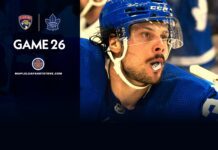


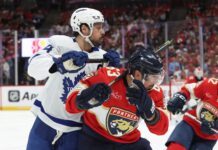
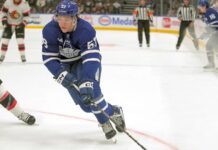
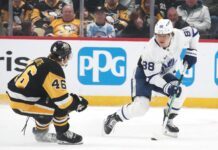
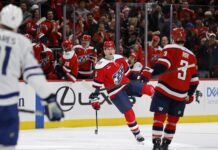

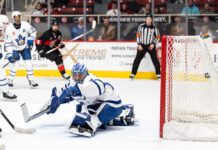
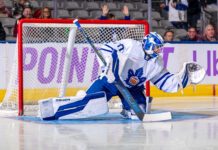



![John Gruden after the Leafs prospects’ 4-1 win over Montreal: “[Vyacheslav Peksa] looked really comfortable in the net… We wouldn’t have won without him” John Gruden, head coach of the Toronto Marlies](https://mapleleafshotstove.com/wp-content/uploads/2025/09/gruden-post-game-sep-14-218x150.jpg)






